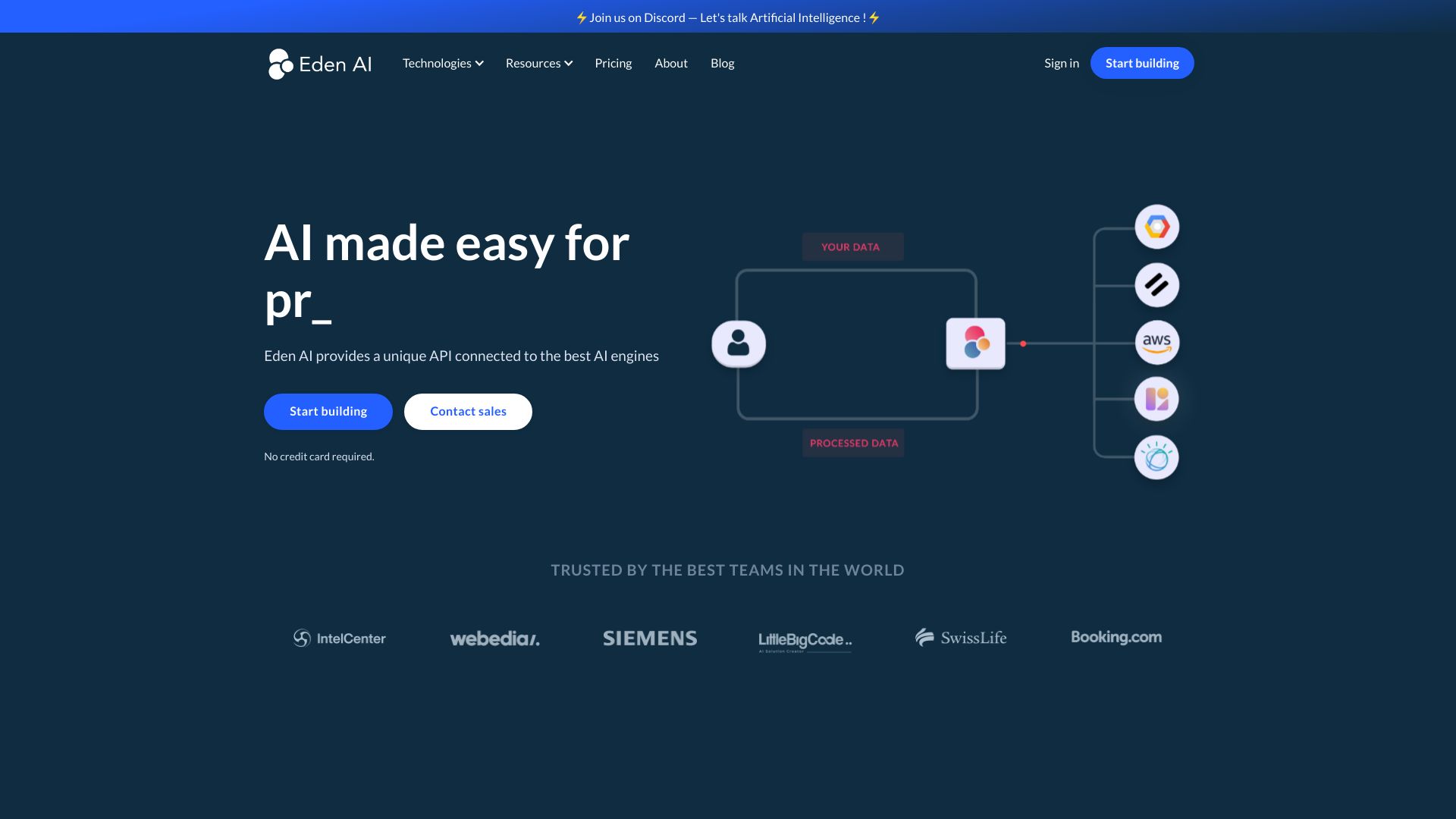
Eden AI
Open Website-
Tool Introduction:One API for generative, NLP, vision—pick best engine, control spend.
-
Inclusion Date:Oct 28, 2025
-
Social Media & Email:
Tool Information
What is Eden AI
Eden AI is a unified API that aggregates leading AI engines across NLP, translation, speech-to-text, OCR and document parsing, computer vision, image/video analysis, and generative models. It helps teams discover alternatives, benchmark accuracy and latency, and route traffic to the best-performing provider at any moment. By abstracting vendor-specific differences and centralizing billing, Eden AI reduces integration effort, avoids lock-in, optimizes cost, and adds observability to manage AI performance at scale.
Eden AI Main Features
- Unified API across providers: Standardized endpoints and responses for translation, NLP, OCR/document parsing, vision, generative text/image, and speech transcription.
- Provider benchmarking: Compare accuracy, latency, and cost to select the best engine for each task and locale.
- Smart routing: Route requests to the most suitable vendor based on performance metrics or explicit rules.
- Cost optimization: Centralized usage tracking, price comparisons, and controls to reduce and manage AI spend.
- Reliability features: Automatic retries and fallbacks to mitigate provider timeouts and regional incidents.
- Observability: Metrics and logs for throughput, latency, and error rates to monitor production workloads.
- Simple integration: Consistent authentication, unified documentation, and SDK-friendly request/response schemas.
- Document AI: OCR and parsing for invoices, IDs, forms, and unstructured PDFs, with structured output.
- Media analysis: Image/video tagging, moderation, and transcription/translation for captions and search.
- Vendor portability: Swap engines without re-architecting code, reducing long-term lock-in risk.
Who Should Use Eden AI
Eden AI suits software teams that need production-ready AI features without committing to a single vendor. it's ideal for product managers testing multiple engines, developers shipping translation, OCR, or transcription at scale, data scientists benchmarking models, and operations teams seeking cost control, resilience, and observability in multi-vendor AI deployments.
Eden AI How-To Steps
- Create an account and obtain your API key.
- Browse the catalog to review supported tasks and available providers.
- Benchmark candidates on your data to assess accuracy, latency, and cost.
- Choose a specific provider or enable routing rules for dynamic selection.
- Integrate the unified API in your app using standardized endpoints and payloads.
- Monitor metrics and costs; set thresholds and fallbacks for reliability.
- Iterate: refine routing, update models, and expand to new tasks as needs grow.
Eden AI Industry Use Cases
E-commerce teams localize product catalogs by combining OCR for supplier PDFs, translation for descriptions, and NLP for attribute extraction. Financial services automate invoice and receipt processing with OCR/document parsing to accelerate reconciliation. Media companies generate captions by using speech-to-text, then translate subtitles for global distribution. Customer support platforms summarize tickets and analyze sentiment with NLP to improve response quality and triage.
Eden AI Pricing
Eden AI typically follows usage-based pricing per API call with unified billing across providers, so teams can consolidate costs and monitor spend in one place. Volume usage may qualify for lower effective rates, and many platforms of this type provide account-level cost controls. For the latest plans and any available trials, please refer to the official pricing page.
Eden AI Pros and Cons
Pros:
- Single, unified API for multi-vendor AI tasks (NLP, OCR, vision, translation, speech).
- Benchmarking and routing to the best-performing engine per task or locale.
- Centralized billing and cost visibility for better budget control.
- Faster integration with standardized schemas and documentation.
- Reduced vendor lock-in and easier provider swaps.
- Improved reliability with retries, fallbacks, and observability.
Cons:
- Performance can vary by provider and region, requiring ongoing monitoring.
- Some advanced, vendor-specific features may not be exposed through a common schema.
- Added dependency on an aggregation layer in addition to underlying providers.
- Data governance and compliance requirements must be validated for each provider used.
Eden AI FAQs
-
What tasks does Eden AI support?
It covers generative AI, translation, text analysis/NLP, OCR and document parsing, image and video analysis, and speech transcription.
-
How does provider selection work?
You can choose a specific vendor or define routing rules based on metrics like accuracy, latency, or cost, using benchmarks to guide selection.
-
Does Eden AI change model accuracy?
No. It normalizes access and helps you pick the best engine. Accuracy and behavior come from the underlying providers and your routing choices.
-
Can I mix multiple providers in one workflow?
Yes. You can orchestrate calls in your application, for example using one engine for OCR and another for translation or summarization.
-
How can I control costs?
Compare prices during benchmarking, set routing to more cost-effective engines when acceptable, and track usage and spend via centralized monitoring.




